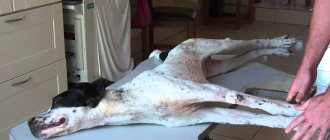Heart attacks occur much less frequently in dogs than in people. However, the consequences of a heart attack are no less dangerous for the health of animals, so every owner should know what signs indicate a heart attack, how to provide first aid, and whether it is possible to diagnose an attack in a dog at home.
Read in this article:
What is this? Signs indicating a heart attack in a dog What can lead to a heart attack? How does a heart attack develop? Main stages Diagnosis of a heart attack in a dog Treatment of a heart attack: what drugs are used? First aid: a reminder for owners Is it possible to prevent a heart attack in a dog?
What is this?
Myocardial infarction is the death of a section of the heart muscle due to a lack of blood supply. In dogs, it rarely occurs because their hearts have developed collateral circulation (lateral blood flow paths). As a result, blood vessels become clogged with atherosclerotic plaques, triggering a heart attack in very rare cases.
On a note! Yes, a dog can have a heart attack. However, heart attacks are rare. The main reason is the peculiarities of lipid metabolism.
If an animal has a heart attack, it will most likely be an intramural form. With this type of heart attack, atherosclerotic plaques clog not the blood vessels that are located directly in the heart muscle, but smaller ones - those that are located deep in the myocardium.
How to make your dog's last days and weeks easier
First of all, take care of adequate protection from pain and, paradoxically... leave him alone if he needs it. In these last days, the dog may instinctively not want to be with us all the time. Its natural behavior is to hide in a safe place.
However, if your pet needs contact and is looking for you with his eyes, be close to him, pet him gently, tell him in a calm and confident voice that everything will be okay. Give him lots of love and attention. However, do not expose him to additional stress, such as contact with new animals, people or small children.
The dog senses our emotions, and it is not difficult to imagine that if we cry all the time, in despair, then the animal will also be very worried about this. If we can restrain ourselves, it will certainly result in him being less stressed in the last days.
It should also be remembered that animals that suffer for a long time are exhausted and freeze just like sick and elderly people. You need to ensure they are comfortable and at the right temperature.
When we know that the moment of goodbye is approaching, I recommend that my clients indulge in delicacies for their pet... cabanas, meatballs, bacon, hamburgers and other "forbidden tastes." This is the moment when we can satisfy the animal without fear. Let him remember the last minutes of his life.
Signs indicating a heart attack in a dog
It is difficult to detect a heart attack in a dog. It is accompanied by general symptoms, so owners often attribute them to other conditions. Signs of myocardial infarction in dogs:
- Cyanosis. Blue discoloration of the mucous membranes of the animal (normally they should be pink and moist). Cyanosis develops against the background of severe oxygen deficiency in the blood. Blue discoloration usually affects the gums, palate, and whites of the eyes.
- Breathing disorders. During a heart attack, your dog's breathing becomes heavy and erratic. It is becoming more frequent. Shortness of breath develops. There may be a feeling of lack of air, which causes the rhythm and depth of breathing to change.
- Weakness, fatigue. The animal refuses physical activity and games. Spends most of his time lying down, mostly on his side. He gets up reluctantly. Additional signs include a shaky and uncertain gait. There may be problems with coordination of movements.
- Painful sensations. In dogs with a heart attack, there is severe pain in the elbow area of the left paw. The pet's sleep is disturbing. The animal often wakes up and jumps up. In severe cases, loss of consciousness is possible. This usually occurs with a sharp decrease in pressure.
- Other changes. During myocardial infarction, aggressive behavior associated with poor health and pain is often observed. The dog may whine for no apparent reason and behave restlessly.
The first signs of a heart attack in a dog can be confused with pulmonary failure. For example, blue discoloration of an animal's mucous membranes occurs not only during a heart attack, but also during problems with the respiratory system (for example, bronchial asthma).
If you notice one or more signs of a heart attack in your dog, seek professional help from your veterinarian. This will help preserve not only the health, but also the life of your beloved pet.
Symptoms of pulmonary diseases
If your dog has a blue tongue and rapid breathing, shortness of breath, coughing, or restlessness, this may indicate pulmonary edema. With such symptoms, only a veterinarian can help. He will prescribe the necessary tests and provide immediate therapy.
At the doctor
These symptoms may indicate a buildup of air (pneumothorax) and fluid (hydrothorax) in the lungs. This may result from trauma to the chest from a blow or bite. In both the first and second cases, the air does not have the opportunity to fill the lungs, so the dog may suffocate.
Note! Failure to provide assistance in time will lead to the death of the animal.
In dogs with a shortened muzzle, such as a bulldog, boxer, or Pekingese, pathology of the velum palatine occurs. This is due to a decrease in the clearance between the larynx and the soft palate, which prevents the flow of oxygen into the lungs. If the tongue of dogs of these breeds falls out and becomes blue, the heartbeat begins to increase, breathing becomes difficult, this may indicate an increase in the tissue of the soft palate.
This pathology is accompanied by shortness of breath. Strong emotions in the form of stress, joy, or pain can cause your pet to faint. Hypertrophy of the velum palatine and increased breathing can be provoked in these breeds by a strong increase in air temperature.
In breeds such as Chihuahuas, Spitz, Toy Terriers, Yorkies, and other dwarf dogs, cyanosis can be caused by a narrowing of the trachea. This can only be detected by an x-ray of the trachea.
The dog feels bad
What can lead to a heart attack?
The only thing that can provoke a heart attack in a dog is a violation of the blood supply. It, in turn, can be caused by various factors. These include:
- Cholesterol plaques . They are an accumulation of fat-like substance in the vessels. Gradually, such formations increase in size and clog the coronary artery. Because of this, tissues stop receiving oxygen, myocardial functions are disrupted, and necrosis begins;
- Ischemic disease . If cholesterol plaques do not completely clog the vessel, then a small amount of blood can pass through. Because of this, it is not a heart attack that develops, but coronary disease. It can also cause necrosis if it develops from an acute to a chronic form;
- Hormonal disorders . Hormonal imbalances rarely lead to heart attacks in dogs, but this factor cannot be ruled out. Even a slight increase or decrease in the level of hormones in the blood can lead to changes throughout the body, and the heart muscle is no exception;
- Neoplasms . Both malignant and benign neoplasms can cause compression of blood vessels. Without medical intervention, it leads to disruption or complete cessation of blood circulation in a certain area;
- Parasitoses . Another cause of heart attacks is parasitic diseases. Dogs may experience heartworm disease, which is caused by a heart parasite. A large number of them leads to blockage of blood vessels;
- Other reasons . Other factors that can impede or completely stop the blood supply to the myocardium include bacterial and viral infections, as well as inflammatory processes affecting the vascular walls.
When blue tongue is normal
For many animals living in extreme cold conditions - bears, wolves - this is a normal phenomenon. Shar-Peis and Chow-Chows have an unusual tongue color; for them it is fixed by the breed standard. Presumably, these two breeds in the distant past descended from wild dogs, and those in turn from wolves, which are now extinct.
Animals with shortened respiratory tracts - bulldogs, pugs - can experience a lack of oxygen in the blood during sleep. Their mouth, lips and even paw pads temporarily acquire a bluish tint when they experience strong emotions, fear, excitement, joy.
Fixed breed standard
This condition of the mucous membrane is also provoked by active walks, the animal being under the scorching rays of the sun, in a stuffy hot room. The color of the mucous membrane returns to normal when the dog calms down, wakes up, and is transferred to a cool room.
To prevent such incidents from happening, you should treat your pet with great attention. You cannot leave your dog in a closed car; you must make sure that it does not overheat in the sun, does not pick up anything edible on a walk, and does not climb through garbage dumps. Chemicals in the house should be kept out of the reach of your pet.
How does a heart attack develop? Main stages
A heart attack in dogs develops gradually:
- Pre-infarction stage . Its duration varies greatly, depending on the cause of the blockage of the blood vessels. Can range from 3-5 hours to a month.
- The most acute stage . It is observed in the animal from the onset of ischemia to the first necrotic changes.
- Acute stage . A feature of this stage is the formation of necrosis. On average, it lasts from 2 to 10 days.
- Subacute stage . Accompanied by the formation of a scar, with granulation tissue gradually replacing necrotic tissue.
- Post-infarction stage . A characteristic sign is scar thickening. At the same time, the animal’s heart muscle gradually adapts to the changes that have occurred.
Infectious hepatitis
This disease in dogs appears most often in puppies aged 1 to 9 months and in individuals that are infected with worms. Both sick people and animals are considered carriers. Infection occurs through the digestive tract.
Symptoms:
The dog may refuse food, have a yellow tint to the eyes and mouth, an elevated body temperature of up to 41.5 C°, shortness of breath, and be lethargic and apathetic.
Virus isolation:
Pathogenic microorganisms appear already on the 5th day through saliva, urine and feces. In the environment, the virus can remain viable in the cold for almost a year, and at room temperature for up to 11 days. For disinfection, iodine, sodium hydroxide and calcium chloride are used.
If you go to the clinic on time, the disease can be defeated and it will not become fatal for the dog.
Prevention:
The disease can only be ruled out by vaccination at a veterinary clinic.
Diagnosing a heart attack in a dog
It is impossible to independently diagnose a heart attack in a dog. This is due to the fact that the clinical picture is quite extensive, and a heart attack can be confused with other diseases. The only correct solution is to contact a veterinarian. It is advisable to immediately contact highly specialized specialists - veterinarians-cardiologists .
A comprehensive examination to determine the diagnosis includes:
- visual inspection of the dog,
- anamnesis collection,
- owner survey,
- blood and urine collection,
- electrocardiography,
- X-ray examination of the chest,
- pressure measurement, etc.
Treatment is always selected individually based on the results of all studies conducted by the veterinarian.
Visit to the veterinarian
At the appointment, the veterinarian examines the four-legged animal, listens to its chest and checks its heart function. To do this, he uses the following research:
- auscultation, detecting extraneous noise;
- pulse oximetry, which measures the degree of oxygen saturation in the blood;
- urine and blood tests to detect concomitant disorders;
- ECG, which determines heart rhythm;
- Ultrasound and x-rays that reveal pathological changes inside the lungs and heart.
The doctor may supplement the standard list with pleural puncture, bronchoalveolar lavage, or other studies. The final amount depends on the difficulty of identifying the main cause of the ailment.
Treatment of heart attack: what drugs are used?
We strongly do not recommend doing the treatment yourself. Do not risk your pet’s life - entrust diagnosis and therapy to veterinarians. They select treatment taking into account the pet’s condition and the characteristics of the heart attack.
To restore the health of the animal, complex therapy is used with the following medications:
- Antiaginal - used for the treatment and prevention of coronary heart disease (CHD), as well as its complications, including myocardial infarction. They improve the supply of oxygen to the heart muscle, therefore ensuring its gradual recovery;
- Anticoagulants – reduce the animal’s blood clotting, therefore reducing the formation of blood clots (thrombi). They are used both for the prevention of cardiovascular diseases and for their treatment;
- Vitamins and minerals – after a heart attack, veterinarians may prescribe vitamin-mineral complexes with a broad composition or individual vitamins (for example, C and B);
- Other drugs to maintain the condition of the heart muscle and its restoration - all drugs are prescribed by the doctor, based on the diagnostic results. They have a positive effect on myocardial contractility, dilate blood vessels, and accelerate urine excretion.
Is it possible to prevent a heart attack in a dog?
One of the most effective prevention measures is a balanced diet. The dog's diet must be correct, containing the necessary vitamins and minerals. Eliminate any fatty foods from your diet, especially from the “human” table.
Provide your pet with regular exercise. They must match the breed, weight and build of the dog. Correctly calculated loads have a positive effect on the entire body, including the heart and blood vessels.
On a note! Fatty foods and lack of exercise are what most often leads to the formation of cholesterol plaques.
And don’t forget about regular checkups with your veterinarian. They will help maintain not only the cardiovascular system, but also the entire body of the pet in good condition.
Pet color
An animal dies due to illness or old age, but unexpected death also occurs. In such a situation, the meaning will take on the most varied, since much depends on the color of the dead dog’s coat.
Black
If a dark-colored pet died in the house, the family was freed from some otherworldly force. According to esotericists, the dog who suddenly died took with him damage and all kinds of curses that ill-wishers brought upon the owners.
With its unexpected death, the animal saved the inhabitants of the house from the destructive effects of the negative program placed on them by the magician.
White
The death of a pet with light fur promises trouble. The unexpected departure of a white dog can predict:
- family quarrels and discord;
- breaking up with a loved one;
- loss of a good friend;
- the beginning of a “black” period, a period of joyless and unpleasant events;
- betrayal or infidelity of the other half.
Ginger
If a dog with fiery fur dies in the house, this is the beginning of financial difficulties. The loss of a red pet symbolizes unsuccessful deals, dismissals from work, friction with superiors and contracts that will only bring losses. Old friends who borrowed money from you may not pay back the debts. Loss and theft are possible.
The red dog is a symbol of material well-being, so its sudden death promises collapse in finance.
Grey
An ash-colored dog is the guardian of the home aura, so its death brings with it problems of a domestic and everyday nature: sudden quarrels with relatives, someone leaving home, conflicts among married couples and difficulties in the relationship between parents and children.
Schoolchildren and students have problems with peers and classmates, as well as poor performance in school or university disciplines.











